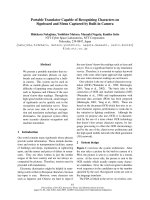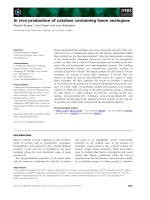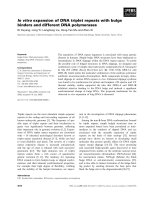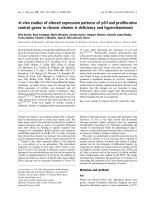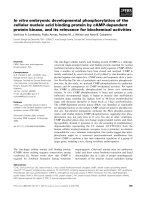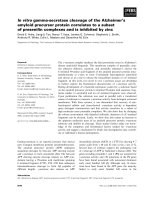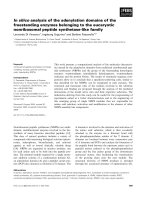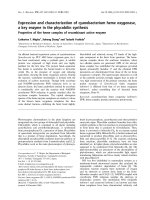báo cáo khoa học: " In vitro behaviour of endothelial cells on a titanium surface" doc
Bạn đang xem bản rút gọn của tài liệu. Xem và tải ngay bản đầy đủ của tài liệu tại đây (1.21 MB, 9 trang )
BioMed Central
Page 1 of 9
(page number not for citation purposes)
Head & Face Medicine
Open Access
Research
In vitro behaviour of endothelial cells on a titanium surface
Ana Cristina Breithaupt-Faloppa
1
, Wothan Tavares de Lima
1
,
Ricardo Martins Oliveira-Filho
1
and Johannes Kleinheinz*
2
Address:
1
Department of Pharmacology, Institute of Biomedical Sciences, University of Sao Paulo, Brazil and
2
Department for Cranio-Maxillofacial
Surgery, University Hospital Muenster, Germany
Email: Ana Cristina Breithaupt-Faloppa - ; Wothan Tavares de Lima - ; Ricardo Martins Oliveira-
Filho - ; Johannes Kleinheinz* -
* Corresponding author
Abstract
Background: Endothelial cells play an important role in the delivery of cells to the inflammation
site, chemotaxis, cell adhesion and extravasation. Implantation of a foreign material into the human
body determines inflammatory and repair reactions, involving different cell types with a plethora of
released chemical mediators. The evaluation of the interaction of endothelial cells and implanted
materials must take into account other parameters in addition to the analysis of maintenance of cell
viability.
Methods: In the present investigation, we examined the behavior of human umbilical vein
endothelial cells (HUVECs) harvested on titanium (Ti), using histological and immunohistochemical
methods. The cells, after two passages, were seeded in a standard density on commercially plate-
shaped titanium pieces, and maintained for 1, 7 or 14 days.
Results: After 14 days, we could observe a confluent monolayer of endothelial cells (ECs) on the
titanium surface. Upon one-day Ti/cell contact the expression of fibronectin was predominantly
cytoplasmatic and stronger than on the control surface. It was observed strong and uniform cell
expression along the time of α5β1 integrin on the cells in contact with titanium.
Conclusion: The attachment of ECs on titanium was found to be related to cellular-derived
fibronectin and the binding to its specific receptor, the α5β1 integrin. It was observed that titanium
effectively serves as a suitable substrate for endothelial cell attachment, growth and proliferation.
However, upon a 7-day contact with Ti, the Weibel-Palade bodies appeared to be not fully
processed and exhibited an anomalous morphology, with corresponding alterations of PECAM-1
localization.
Background
Since the discovery of endothelial-derived relaxing factor
(EDRF) by Furchgott & Zawadzki [1], in 1980, endothelial
cells (ECs) have been recognized to be involved in vascu-
lar homeostasis, angiogenesis and repair of injured tis-
sues. ECs play an important role in the trafficking of cells
from bloodstream towards an inflammatory site, chemo-
taxis, cell adhesion and extravasation [2]. Factors released
by ECs mediate the control of vascular tonus, thrombo-
genesis and fibrinolysis, and platelet activities [3]. Besides,
by interacting with cytokines and leukocytes, ECs orches-
trate the inflammatory process [4], a fact involved with
Published: 23 July 2008
Head & Face Medicine 2008, 4:14 doi:10.1186/1746-160X-4-14
Received: 10 March 2008
Accepted: 23 July 2008
This article is available from: />© 2008 Breithaupt-Faloppa et al; licensee BioMed Central Ltd.
This is an Open Access article distributed under the terms of the Creative Commons Attribution License ( />),
which permits unrestricted use, distribution, and reproduction in any medium, provided the original work is properly cited.
Head & Face Medicine 2008, 4:14 />Page 2 of 9
(page number not for citation purposes)
the complex phenomena observed at the host implant
interface. ECs produce and store the haemosthatic protein
von Willebrand factor (vWf) into granules named Weibel
Palade bodies (WPBs), that are secretory organelles. They
thus provide a readily releasable pool of extracellular VWF
as well as placing P-selectin on the plasma membrane
whereby it can recruit leukocytes and thus play a role in
the initiation of inflammation [5].
Implantation of a foreign material into the intimity of
human tissues triggers a typical inflammatory response
followed by tissue repair. After implanted, the material
will determine the clinical outcome and will have an
influence on the implantation bed, triggering cellular and
non-cellular responses [6]. Metals and alloys are the most
common materials used as surgical implants in order to
replace mineralised structures [7,8]. In particular, tita-
nium alloys show properties which render them suitable
substrates for surgical implant [6,8]. Moreover, the high
degree of biocompatibility of titanium and its alloys is
intimately related to the passively formed oxide film on
the metallic surface [9,10].
Noteworthy, the evaluation of the interaction of cells and
implanted materials must take into account other param-
eters in addition to the analysis of maintenance of cell via-
bility. Indeed, the interaction of implants with host cells,
and in particular with endothelial cells, might cause acti-
vation of adhesion molecules culminating with cytokine
generation [2]. In fact, the degree of expression of adhe-
sion molecules on the surface of human ECs depends on
the response of the cells against the implanted material
[11].
PECAM-1 is a cell-cell junction molecule that establishes
homophilic binding between neighboring ECs [12].
PECAM-1 interacts with the underlying cytoskeleton and
regulates F-actin assembly at the cell periphery in associa-
tion with changes in cell shape and spreading [13]. The
mechanism of endothelial cell adhesion to substrates
involves integrins expression, thence connecting extracel-
lular matrix (ECM) with the cytoskeleton [14,15].
Integrins are also considered to be the main receptors of
ECM proteins, such as fibronectin, laminin, collagens,
and vitronectin. Altogether, these proteins constitute the
main mediators of cell-ECM adhesion [14].
There is evidence that upon binding to an ECM protein
(e.g. fibronectin), a number of integrins mediate cellular
signaling and functions. It was shown that α5β1 integrin,
a receptor for both fibronectin (FN) and vitronectin (VN),
and αvβ3 integrin, a VN receptor, both play a role in ang-
iogenesis [16]. Therefore, the success of vasculogenesis
and angiogenesis depends on FN [17,18] and its main
receptor, the α5β1 integrin [19]. Upon wound repair, ang-
iogenetic mechanisms are called into play leading to gen-
eration of new capillary blood vessels [20]. Accordingly,
angiogenesis is of pivotal importance during the initial
healing process, and thus the characterization of the cellu-
lar responses involved in angiogenesis and bone forma-
tion adjacent to the implants is critical to understanding
and promoting implant biocompatibility and improving
stable fixation of implants [21].
Tissue repair around an implanted piece of Ti depends
crucially on osseous integration and angiogenesis.
Though a huge deal of information exist about bone mod-
ifications in this situation, the interaction of this metal
with endothelial cells is not completely understood. Being
so, in this study we investigated the behavior of ECs in cul-
ture on Ti plates and assessed the protein expression and
cell adhesion, in an attempt to better understand the rea-
sons why Ti-made implant materials achieve successful
clinical application.
Materials and methods
The experimental design was approved by the Ethics Com-
mittee, Faculty of Medicine, University of Münster. The
material analyzed in this study was commercially availa-
ble, plate-shaped pieces of pure titanium (Ti). As control
surfaces, we used round plastic coverslips (Thermanox
®
,
Nunc, USA) coated with gelatin (Sigma, USA).
Antibodies
All antibodies were used as purified IgGs. Monoclonal
antibodies: anti-human CD-31 (PECAM-1), anti-human
vinculin (Sigma, USA); anti-human fibronectin receptor
(Takara Biomedicals, Japan); anti-human vitronectin,
anti-human vitronectin receptor and anti-human VE-cad-
herin (Chemicon International, USA); anti-human α-
smooth muscle actin (ICN Biomedicals, USA). Polyclonal
antibodies: anti-human von Willebrand factor (vWf)/fac-
tor VIII (ICN Biomedicals, USA) and anti-fibronectin
(Biotrend, Germany). Second antibodies: alexa fluor 488
goat anti-mouse, and anti-rabbit.
Cultures of human umbilical vein endothelial cells
(HUVECs)
The endothelial cells were isolated from umbilical cord
veins essentially as described by Marin et al. [22], accord-
ing to the method of Jaffe et al. [23]. Cells were pooled
and established as primary cultures seeded on 0,5% gela-
tin-coated (gelatin 2% solution) tissue culture dishes in
medium 199 enriched with 20% heat-inactivated fetal
bovine serum, 5 μg/ml amphotericin B, 200 U/ml penicil-
lin, 200 μg/ml streptomycin, 1% endothelial cell growth
supplement, and 0,1% heparin. Cultures were carried out
at 37°C in a humidified atmosphere with 5% CO
2
; the
culture medium was changed every other day. The cul-
tures were serially passaged by incubating confluent cells
Head & Face Medicine 2008, 4:14 />Page 3 of 9
(page number not for citation purposes)
in 0.05% trypsin/0.02% EDTA solution and replating
them at a 1:2 ratio. Second passage cells were taken for the
experiments after being identified as endothelial cells by
staining with a panel of endothelial-specific antibodies
(anti-vWF, anti-CD-31 [PECAM-1]) and by a negative
staining to anti-α-smooth muscle actin.
Contact assays
Detachment of cells was performed by trypsinisation dur-
ing 1 min; the reaction was stopped by dilution with
enriched medium and the resulting suspensions were cen-
trifuged (1,200 rpm for 3 min). The pellet was resus-
pended in growth medium. Cell numbers were
determined with a cell counter. Titanium plates (1 cm
2
)
were placed onto the bottoms of 24-well plates, and the
cells were seeded in every well at a density of 8 × 10
4
cells/
cm
2
. As control surfaces, we used round pieces (plastic
coverslips) with the same dimensions, coated with gelatin
and seeded with the same concentration of cells. The
experiments were carried out during 1, 7 or 14 days and
the media were changed every other day.
Immunohistochemistry
At the end of every culture period, both cell substrates
were processed with a fluorescent staining method and
studied with a confocal microscope. For this purpose, the
substrates inside the wells were rinsed with PBS and fixed
in methanol for 20 minutes at -4°C. Non-specific sites
were then blocked by incubation during 15 minutes at
room temperature with Tris-buffered saline/Tween 20
®
(TBST) containing 0.5% bovine serum albumin. After-
wards, the substrates were incubated with the primary
antibodies during 1 h at 37°C, rinsed three times with
TBST and then incubated with the correspondent alexa
fluor 488 second antibody for 1 h at 37°C. Negative con-
trols were prepared using incubations with primary anti-
bodies-free saline. Images of the stained probes were
captured using a confocal microscope (Zeiss Axiovert).
Scanning electron microscopy
The titanium plates were fixed with 2.5% glutaraldehyde
and then dehydrated using a graded ethanol series. The
process was completed by critical point drying using CO
2
and a thin layer of gold was sputter-coated onto the plates
prior to examination. The images of the surfaces were cap-
tured using a Philips PSEM500× microscope.
Cell countings
After the corresponding culture periods, titanium and
control pieces were rinsed with PBS to eliminate unat-
tached cells. The adherent cells were removed by incuba-
tion with trypsin/EDTA for 2 minutes at 37°C. Trypsin
action was stopped by dilution with complete growth
medium at room temperature and 100 μl-samples of the
resulting cell suspensions were counted using a cell coun-
ter (Casy
®
1, Schärfe System, Germany). Results were
expressed as the number of adherent cells per sample of
titanium or control and were analyzed by one-way analy-
sis of variance and the Tukey-Kramer multiple compari-
sons test. A 2.01 version GraphPad InStat™ software was
used for this purpose. When appropriate, the Student's t
test was also used.
Results
Material characterization
Images of titanium plates showed the surface topography
and revealed the presence of regular parallel grooves (Fig-
ure 1).
Cell morphology
The morphological observations indicated that the cells
seeded on titanium seem to conform to the material sur-
face and to be flat, elongated and oriented along the tita-
nium grooves (Figure 2A). After 7 days we could observe
the presence of increased number of cells; after 14 days
there was a confluent and dense cell layer (Figure 2B).
Cells over the control surface maintained their morpho-
logical patterns without any significant volume variation
or other modifications.
Titanium assays and immunohistochemistry
HUVECs adhered to the surface, spread and proliferated
and within 24 hours started forming a subconfluent mon-
olayer. On titanium and on control surfaces it could be
noticed that the cells proliferated and reached confluence,
throughout the experimental period.
Stainings with antibodies anti- PECAM-1 and anti-vWf
were performed to confirm the conservation of the
Scanning electron microscopy aspect of titanium plate with-out cells (2500 ×)Figure 1
Scanning electron microscopy aspect of titanium
plate without cells (2500 ×).
Head & Face Medicine 2008, 4:14 />Page 4 of 9
(page number not for citation purposes)
endothelial characteristics. There was a mild up to strong
expression of PECAM-1 by the cells and no expression was
evidenced on the cellular processes after 7 days (Figures
3A, B and 3C). Conversely, on the control surfaces the
CD-31 expression did not vary during the studied periods
(Figures 3D, E and 3F). Cells tested for vWf showed the
presence of this factor on titanium and on control sur-
faces, but on titanium after 7 and 14 days we could not
observe well-defined granules in the cells and after 7 days
they are distributed on the perinuclear region (Figure 4B
and 4C). Conversely, on control surfaces the cells pre-
sented well-defined vWf granules uniformly distributed in
the cells in all studied periods (Figures 4D, E and 4F).
The cells were also studied for the presence of extracellular
matrix proteins, fibronectin and vitronectin. The results
on both surfaces showed a strong positive reaction for
fibronectin with a progressively intensity increase. Upon
one-day Ti/cell contact the expression of fibronectin was
predominantly cytoplasmatic and stronger than on the
control surface (Figure 5A and 5D). After 7 and 14 days we
observed that fibronectin was predominantly extracellular
on both surfaces (Figures 5B, C, E and 5F). In contrast, no
positive responses were obtained with the specific anti-vit-
ronectin antibody.
Assays for VE-cadherin expression resulted negative, both
on control and titanium surfaces for any experimental
period studied.
The assays for integrins α5β1 (Figure 6) and α(v)β3 (Fig-
ure 7) revealed strong and uniform cell expression along
the time, with a stronger reaction for α5β1 on the cells in
contact with titanium or control surfaces.
Similar testings were done for vinculin; the staining was
positive and did not significantly vary along the time. The
subcellular distribution of this protein, along the Ti/cell
contact time, was similar to that of the α5β1 integrin
found after 7 days.
Cell countings
Figure 8 shows the number of cells attached to titanium
and control surfaces after the different growing periods (1,
7 or 14 days). Overall, there was an increasing number of
cells adhered to the substrates along the time, without sig-
nificant difference between titanium and control surface.
Discussion
Besides requiring invasion by endothelial cells (ECs), ang-
iogenesis depends upon localized proteolytic modifica-
tions of the extracellular matrix (ECM) and/or a substrate
to which ECs can adhere, migrate upon, proliferate
within, and eventually differentiate into a mature EC phe-
notype. The physical characteristics as well as the compo-
sition of the material must be suitable for cell adherence,
because focal adhesions can only be formed and main-
tained when the material sustains cell adhesion. The cel-
lular response to a foreign material is dictated largely by
the surface properties of the material to which the cells
contact. A better understanding of the role of occurring
matrix in the various steps of angiogenesis would conceiv-
ably contribute to the intelligent design of tissue-engi-
neered constructs where angiogenesis is critical for tissue
repair and restoration [24].
Results from van Kooten et al. [25] showed that HUVECs
adhere to metal surfaces and start forming a subconfluent
monolayer within 3 days, and that focal contacts are
present after 3 days of adhesion, with the cells still dis-
playing their endothelial phenotype. It has been demon-
strated that various specific proteins adsorb onto the
Scanning electron microscopy image of endothelial cells attached to the titanium plate after 1 day of culture (A) and after 14 days (B) (1250 ×)Figure 2
Scanning electron microscopy image of endothelial
cells attached to the titanium plate after 1 day of cul-
ture (A) and after 14 days (B) (1250 ×).
Head & Face Medicine 2008, 4:14 />Page 5 of 9
(page number not for citation purposes)
scaffolds used for culture from serum-containing medium
in vitro, and that cells use specific integrin receptors to
bind to these proteins [26].
Tissue repair around an implanted piece of Ti depends
crucially on osseous integration and angiogenesis.
Though a huge deal of information exist about bone mod-
ifications in this situation, the interaction of endothelial
Images of the immunohistochemical assays: von Willebrand factor on endothelial cells attached to titanium after (A) 24 hours, (B) 7 days and (C) 14 days, and to control surface after (D) 24 hours, (E) 7 days and (F) 14 daysFigure 4
Images of the immunohistochemical assays: von Willebrand factor on endothelial cells attached to titanium
after (A) 24 hours, (B) 7 days and (C) 14 days, and to control surface after (D) 24 hours, (E) 7 days and (F) 14
days.
Images of the immunohistochemical assays: PECAM-1 on endothelial cells attached to titanium after (A) 24 hours, (B) 7 days and (C) 14 days, and to control surface after (D) 24 hours, (E) 7 days and (F) 14 daysFigure 3
Images of the immunohistochemical assays: PECAM-1 on endothelial cells attached to titanium after (A) 24
hours, (B) 7 days and (C) 14 days, and to control surface after (D) 24 hours, (E) 7 days and (F) 14 days.
Head & Face Medicine 2008, 4:14 />Page 6 of 9
(page number not for citation purposes)
cells with Ti is not completely understood. A permanent
state of oxidative stress appears to exist in endothelial cells
grown in direct contact with Ti surfaces [27]. These
authors showed that HUVECs adhere to Ti in vitro and a
complete coverage of an EC layer was obtained without
any coating or surface treatment.
Images of the immunohistochemical assays: fibronectin on endothelial cells on titanium after (A) 24 hours, (B) 7 days and (C) 14 days and on control surface after (D) 24 hours, (E) 7 days and (F) 14 daysFigure 5
Images of the immunohistochemical assays: fibronectin on endothelial cells on titanium after (A) 24 hours, (B)
7 days and (C) 14 days and on control surface after (D) 24 hours, (E) 7 days and (F) 14 days.
Images of the immunohistochemical assays: α5β1 integrin expression on endothelial cells attached to titanium after (A) 24 hours, (B) 7 days and (C) 14 days and to control surface (D)Figure 6
Images of the immunohistochemical assays: α5β1 integrin expression on endothelial cells attached to titanium
after (A) 24 hours, (B) 7 days and (C) 14 days and to control surface (D).
Head & Face Medicine 2008, 4:14 />Page 7 of 9
(page number not for citation purposes)
Cell adhesion to implants in vivo and to culture surfaces in
vitro is typically dependent upon surface-adsorbed
fibronectin and vitronectin [28]. After 1 day on titanium
(see Fig. 5) it could be observed a strong cytoplasmatic
pool of fibronectin on ECs and a growing extracellular
mesh. Conversely, on control surfaces that fibronectin
pool was not observed. After 7 days this protein was found
over both surfaces with a more dense mesh on the control
surfaces. The cells produced and released fibronectin in
order to use this protein as a substrate for attachment,
with a stronger presence in the cells after 1 day on tita-
nium. On control surfaces the initial attachment was most
conceivably based on the gelatin coat. Although it has
been stated that over time the adhesion may be progres-
sively more dependent on vitronectin in view of the larger
amounts, or the preferential binding to this molecule
[29,30], our data do not support this view, since our EC
vitronectin stainings failed to demonstrate any positive
answer either on titanium or control surfaces. Our find-
ings showed that ECs produced and eliminated endog-
enous fibronectin, using this protein to attach to the
surface through integrins (namely, αvβ1 and αvβ3) which
are expressed when ECs were seeded on titanium. The
observed expression of αvβ3 was weaker in comparison to
that of α5β1 (Figs. 6 and 7).
The EC morphology on titanium plates was not altered.
However, WPBs were not well-defined after 7 and 14 days
and they were distributed on the perinuclear region. Some
authors report that only fully processed, substantially
polymerized and functionally mature vWf is stored in the
WPBs, together with its propeptide [31]. Interestingly, it is
established that HUVECs poses two different populations
of WPBs, that are differentiated at cellular level by their
distribution, the newly formed ones being immature and
located in the perinuclear region [5]. Thus it is conceivable
Attachment of HUVECs on titanium and on control surfaces after the studied periodsFigure 8
Attachment of HUVECs on titanium and on control
surfaces after the studied periods. Values are mean ±
SEM.
Images of the immunohistochemical assays: α(v)β3 integrin expression on endothelial cells attached to titanium after (A) 24 hours, (B) 7 days and (C) 14 days and to control surface (D)Figure 7
Images of the immunohistochemical assays: α(v)β3 integrin expression on endothelial cells attached to tita-
nium after (A) 24 hours, (B) 7 days and (C) 14 days and to control surface (D).
Head & Face Medicine 2008, 4:14 />Page 8 of 9
(page number not for citation purposes)
to infer that on titanium, after 7 and 14 days, the WPB on
HUVECs were immature in nature as judged by their dis-
tribution (Fig. 4) whereas the mature granules were
secreted. On the other hand, the presence and the distri-
bution of the WPBs on HUVECs on control surfaces were
uniform in all studied periods.
Since PECAM-1-mediated pathway could be involved in
the observed differences in cell behavior, the expression
level of PECAM-1 on titanium was analyzed. CD-31
(PECAM-1) was expressed mildly up to strongly by the
cells on Ti, but we could not observe the expressed CD-31
on the cellular processes after 7 days (Fig. 3). Since this
was not observed with control surfaces, those cell contact
alterations might well be due to an effect of titanium on
HUVECs.
Our results did not show the presence of VE-cadherin
within junctions in all periods studied neither in contact
with titanium nor with the control surface. This could be
an evidence of a lack of some stimulus (i) for this mole-
cule to trigger its participation on the junctions.
Conclusion
In conclusion, our data indicated that the attachment of
ECs on titanium could be related to cellular-derived
fibronectin and the binding to its specific receptor, the
α5β1 integrin. It was observed that titanium effectively
serves as a suitable substrate for endothelial cell attach-
ment, growth and proliferation in the initial phase. It is
suggested to describe this feature of titanium if not ang-
iogenic then at least angio-conductive. However, upon a
7-day contact with Ti the Weibel-Palade bodies were
found to be not fully processed and with altered morphol-
ogy, which corresponding alterations of PECAM-1 locali-
zation. In fact that the successful Ti devices implantation
coexists with the microscopical subclinical adverse effects
is, at the present, unresolved.
Authors' contributions
ACB–F performed all experiments under the supervision
of JK. ACB–F drafted the manuscript and was advised by
RMO–F and WTdL. All authors read and approved the
final manuscript.
Acknowledgements
We thank Mrs. Schuette, Mrs. Hartmann and Mr. Huda for their useful and
informative technical assistance.
ACBF was recipient of Deutscher Akademischer Austausch Dienst
(DAAD)/CAPES fellowship.
References
1. Furchgott RF, Zawadzki JV: The obligatory role of endothelial
cells in the relaxation of arterial smooth muscle by ACh.
Nature 1980, 288:373-376.
2. Santos MI, Fuchs S, Gomes ME, Unger RE, Reis RL, Kirkpatrick CJ:
Response of micro- and macrovascular endothelial cells to
starch-based fiber meshes for bone tissue engineering. Bio-
materials 2007, 28(2):240-248.
3. Davies MG, Hagen PO: The vascular endothelium. A new hori-
zon. Ann Surg 1993, 218:593-609.
4. Bruni S, Martinesi M, Stio M, Treves C, Bacci T, Borgioli F: Effects of
surface treatment of Ti-6Al-4V titanium alloy on biocompat-
ibility in cultured human umbilical vein endothelial cells. Acta
Biomater 2005, 1(2):223-34.
5. Harrison-Lavoie KJ, Michaux G, Hewlett L, Kaur J, Hannah MJ, Lui-
Roberts WWY, Norman KE, Cutler DF: P-selectin and CD63 use
different mechanisms for delivery to Weibel-Palade bodies.
Traffic 2006, 7(6):647-62.
6. Ramires PA, Giufrida A, Milella E: Three-dimensional reconstruc-
tion of confocal laser microscopy images to study the behav-
iour of osteoblastic cells grown on biomaterials. Biomaterials
2002, 23:397-406.
7. Williams JM, Buchanan RA: Ion implantation of surgical Ti-6Al-
4V alloy. Mater Sci Eng 1985, 69:237-46.
8. Long M, Rack HJ: Titanium alloys in total joint replacement–a
materials science perspective. Biomaterials 1998, 19:1621-39.
9. Lausmaa J, Mattson L, Rolander U, Kasemo B: Chemical composi-
tion and morphology of titanium surface oxides. Mater Res Soc
Symp Proc 1986, 55:351-9.
10. Ito M, Azuma Y, Ohta T, Komorita K: Effects of ultrasound and
1,25-dihydroxyvitamin D
3
on growth factor secretion in co-
cultures of osteoblasts and endothelial cells. Ultrasound Med
Biol 2000, 26:161-6.
11. Pu FR, Williams RL, Markkula TK, Hunt JA: Effects of plasma
treated PET and PTFE on expression of adhesion molecules
by human endothelial cells in vitro. Biomaterials 2002,
23:2411-28.
12. Albelda SM, Buck CA: Integrins and other cell adhesion mole-
cules. FASEB J 1990, 4:2868-2880.
13. Newman PJ, Newman DK: Signal transduction pathways medi-
ated by PECAM-1: new roles for an old molecule in platelet
and vascular cell biology. Arterioscler Thromb Vasc Biol 2003,
23:953-64.
14. Alexander JS, Elrod JW: Extracellular matrix, junctional integ-
rity and matrix metalloproteinase interactions in endothe-
lial permeability regulation. J Anat 2002, 200:561-74.
15. Breithaupt-Faloppa AC, Kleinheinz J, Crivello O Jr: Endothelial cell
reaction on a biological material. J Biomed Mater Res B Appl Bio-
mater 2006, 76(1):49-55.
16. Ruegg C, Mariotti A: Vascular integrins: pleiotropic adhesion
and signaling molecules in vascular homeostasis and angio-
genesis. Cell Mol Life Sci 2003, 60(6):1135-57.
17. George EL, Georges-Labouesse EN, Patel-King RS, Rayburn H, Hynes
RO: Defects in mesoderm, neural tube and vascular develop-
ment in mouse embryos lacking fibronectin. Development
1993, 119:1079-1091.
18. George EL, Baldwin HS, Hynes RO: Fibronectins are essential for
heart and blood vessel morphogenesis but are dispensable
for initial specification of precursor cells. Blood 1997,
90:3073-3081.
19. Francis SE, Goh KL, Hodivala-Dilke K, Bader BL, Stark M, Davidson
D, Hynes RO: Central roles of alpha5beta1 integrin and
fibronectin in vascular development in mouse embryos and
embryoid bodies. Arterioscler Thromb Vasc Biol 2002, 22:
927-933.
20. Folkman J, Shing Y: Angiogenesis. J Biol Chem 1992, 267:10931-34.
21. Smith RA, Mosesson MW, Daniels AU, Gartner TK: Adhesion of
microvascular endothelial cells to metallic implant surfaces.
J Mater Sci: Mater Med 2000, 11:279-285.
22. Marin V, Kaplanski G, Grès S, Farnarier C, Bongrand P: Endothelial
cell culture: protocol to obtain and cultivate human umbili-
cal endothelial cells. J Immunol Methods 2001, 254:183-90.
23. Jaffe EA, Nachmann RL, Becker CG, Minick CR: Culture of human
endothelial cells derived from umbilical veins – identification
by morphologic and immunologic criteria. J Clin Invest 1973,
52:2745.
24. Dixit P, Hern-Anderson D, Ranieri J, Schmidt CE: Vascular graft
endothelization: comparative analysis of canine and human
endothelial cell migration on natural biomaterials. J Biomed
Mater Res 2001, 56:545-55.
Publish with BioMed Central and every
scientist can read your work free of charge
"BioMed Central will be the most significant development for
disseminating the results of biomedical researc h in our lifetime."
Sir Paul Nurse, Cancer Research UK
Your research papers will be:
available free of charge to the entire biomedical community
peer reviewed and published immediately upon acceptance
cited in PubMed and archived on PubMed Central
yours — you keep the copyright
Submit your manuscript here:
/>BioMedcentral
Head & Face Medicine 2008, 4:14 />Page 9 of 9
(page number not for citation purposes)
25. van Kooten TG, Klein CL, Kirkpatrick CJ: Cell-cycle control in
cell-biomaterial interactions: expression of p53 and Ki67 in
human umbilical vein endothelial cells in direct contact and
extract testing of biomaterials. J Biomed Mater Res 2000,
52:199-209.
26. Baccells M, Edelman ER: Effect of pre-absorbed on attachment,
proliferation, and function of endothelial cells. J Cell Physiol
2002, 191:155-61.
27. Tsaryk R, Kalbacova M, Hempel U, Scharnweber D, Unger RE, Dieter
P, Kirkpatrick CJ, Peters K: Response of human endothelial cells
to oxidative stress on Ti6Al4V alloy. Biomaterials 2007,
28(5):806-13.
28. Grinnell F, Feld MK: Fibronectin adsorption on hydrophilic and
hydrophobic surfaces detected by antibody binding and ana-
lyzed during cell adhesion in serum-containing medium. J Biol
Chem 1982, 257(9):4888-93.
29. Garner B, Hodgson AJ, Wallace GG, Underwood PA: Human
endothelial cell attachment to and growth on polypyrrole-
heparin is vitronectin dependent. J Mater Sci Mater Med 1999,
10(1):19-27.
30. Nikolovski J, Mooney DJ: Smooth muscle cell adhesion to tissue
engineering scaffolds. Biomaterials 2000, 21:2025-32.
31. De Wit TR, Van Mourik JA: Biosynthesis, processing and secre-
tion of von Willebrand factor: biological implications. Best
Pract Res Clin Haematol 2001, 14(2):241-55.
